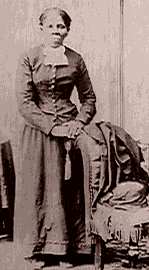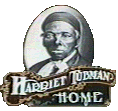
 |
|
Harriet Tubman's life was a monument to courage and determination that continues to stand out in American history. Born into slavery in Maryland, Harriet Tubman freed herself, and played a major role in freeing the remaining millions. After the Civil War, she joined her family in Auburn, NY, where she founded the Harriet Tubman Home. Click here to learn more about:
Harriet Ross was born into slavery in 1819 or 1820, in Dorchester County, Maryland. Given the names of her two parents, both held in slavery, she was of purely African ancestry. She was raised under harsh conditions, andsubjected to whippings even as a small child. At the age of 12 she was seriously injured by a blow to the head, inflicted by a white overseer for refusing to assist in tying up a man who had attempted escape.
At the age of 25, she married John Tubman, a free African American. Five years later, fearing she would be sold South, she made her escape.
Tubman was given a piece of paper by a white neighbor with two names, and told how to find the first house on her path to freedom. At the first house she was put into a wagon, covered with a sack, and driven to her next destination. Following the route to Pennsylvania, she initially settled in Philadelphia,where she met William Still, the Philadelphia Stationmaster on the Underground Railroad. With the assistance of Still, and other members of the Philadelphia Anti-Slavery Society, she learned about the workings of the UGRR.
In 1851 she began relocating members of her family to St. Catherines, (Ontario) Canada West. North Street in St. Catherines remained her base of operations until 1857. While there she worked at various activities to save to finance her activities as a Conductor on the UGRR, and attended the Salem Chapel BME Church on Geneva Street.
After freeing herself from slavery, Harriet Tubman returned to Maryland to rescue other members of her family. In all she is believed to have conducted approximately 300 persons to freedom in the North. The tales of her exploits reveal her highly spiritual nature, as well as a grim determination to protect her charges and those who aided them. She always expressed confidence that God would aid her efforts, and threatened to shoot any of her charges who thought to turn back.
When William Still published The Underground Railroad in 1871, he included a description of Harriet Tubman and her work. The section of Still's book captioned below begins with a letter from Thomas Garret, the Stationmaster of Wilmington, Delaware. Wilmington and Philadelphia were on the major route followed by Tubman, and by hundreds of others who escaped from slavery in Maryland. For this reason, Still was in a position to speak from his own firsthand knowledge of Tubman's work:
WILMINGTON, 12 mo. 29th, 1854
Esteemed Friend, J. Miller McKim: - We made arrangements last night, and sent away Harriet Tubman, with six men and one woman to Allen Agnew's, to be forwarded across the country to the city. Harriet, and one of the men had worn the shoes off their feet, and I gave them two dollars to help fit them out, and directed a carriage to be hired at my expense, to take them out, but do not yet know the expense....
THOMAS GARRET
Harriet Tubman had been their "Moses," but not in the sense that Andrew Johnson was the "Moses of the colored people." She had faithfully gone down into Egypt, and had delivered these six bondmen by her own heroism. Harriet was a woman of no pretensions, indeed, a more ordinary specimen of humanity could hardly be found among the most unfortunate-looking farm hands of the South. Yet, in point of courage, shrewdness and disinterested exertions to rescue her fellow-men, by making personal visits to Maryland among the slaves, she was without her equal.
Her success was wonderful. Time and again she made successful visits to Maryland on the Underground Rail Road, and would be absent for weeks at a time, running daily risks while making preparations for herself and her passengers. Great fears were entertained for her safety, but she seemed wholly devoid of personal fear. The idea of being captured by slave-hunters or slave-holders, seemed never to enter her mind. She was apparently proof against all adversaries. While she thus maintained utter personal indifference, she was much more watchful with regard to those she was piloting. Half of her time, she had the appearance of one asleep, and would actually sit down by the road-side and go fast asleep* when on her errands of mercy through the South, yet, she would not suffer one of her party to whimper once, about "giving out and going back," however wearied they might be by the hard travel day and night. She had a very short and pointed rule or law of her own, which implied death to any who talked of giving out and going back. Thus, in an emergency she would give all to understand that "times were very critical and therefore no foolishness would be indulged in on the road." That several who were rather weak-kneed and faint-hearted were greatly invigorated by Harriet's blunt and positive manner and threat of extreme measures, there could be no doubt.
After having once enlisted, "They had to go through ordie." Of course Harriet was supreme, and her followers generally had full faith in her, and would back up any word she might utter. So when she said tothem that "a live runaway could do great harm by going back, but that a dead one could tell no secrets," she was sure to have obedience. Therefore, none had to die as traitors on the "middle passage." It is obvious enough, however, that her success in going into Maryland as she did, was attributable to her adventurous spirit and utter disregard of consequences. Her like it is probable was never known before or since.
On the road between Syracuse and Rochester, would be found a number of sympathetic Quakers and other abolitionists settled at Auburn. Here also was the home of US Senator and former New York State Governor William H. Seward. Sometime in the mid-1850s, Tubman met Seward and his wife Frances. Mrs. Seward provided a home for Tubman's favorite niece, Margaret, after Tubman helped her to escape from Maryland. In 1857, the Sewards provided a home for Tubman, to which she relocated her parents from St. Catherines. This home was later sold to her for a small sum, and became her base of operations when she was not on the road aiding fugitives from slavery, and speaking in support of the cause.
Tubman was closely associated with Abolitionist John Brown, and was well acquainted with the other Upstate abolitionists, including Frederick Douglass, Jermain Loguen, and Gerrit Smith.She worked closely with Brown, and reportedly missed the raid on Harper's Ferry only because of illness.
After the outbreak of the Civil War, Tubman served as a soldier, spy, and a nurse, for a time serving at Fortress Monroe, where Jefferson Davis would later be imprisoned. While guiding a group of black soldiers in South Carolina, she met Nelson Davis, who was ten years her junior. Denied payment for her wartime service, Tubman was forced, after a bruising fight, to ride in a baggage car on her return to Auburn.
* note: Harriet Tubman reportedly suffered narcolepsy as a result of the head injury she sustained as a child.
 After
the close of the Civil War, Harriet Tubman returned to Auburn, NY. There she
married Nelson Davis, and lived in a home they built on South Street, near the
original house. This house still stands on the property, and serves as a home
for the Resident Manager of the Harriet Tubman Home.
After
the close of the Civil War, Harriet Tubman returned to Auburn, NY. There she
married Nelson Davis, and lived in a home they built on South Street, near the
original house. This house still stands on the property, and serves as a home
for the Resident Manager of the Harriet Tubman Home.
Only twelve miles from Seneca Falls, Tubman helped Auburn to remain a centerof activity in support of women's rights. With her home literally down the road, Tubman remained in contact with her friends, William and Frances Seward. In 1908, she built the wooden structure that served as her home for the aged and indigent. Here she worked, and herself was cared for in the period before her death in 1913.
 Afterher
death, Harriet Tubman was buried in Fort Hill Cemetery in Auburn [grave], with
military honors. She has since received man honors, including the naming of the
Liberty Ship Harriet Tubman, christened in 1944[photo] by Eleanor Roosevelt. On June 14, 1914 a large
bronze plaque was placed at the Cayuga County Courthouse, and a civic holiday
declared in her honor. Freedom Park, a tribute to the memory of Harriet Tubman,
opened in the summer of 1994 at 17 North Street in Auburn. In 1995, Harriet
Tubman was honored by the federal government with a commemorative postage stamp
bearing her name and likeness.
Afterher
death, Harriet Tubman was buried in Fort Hill Cemetery in Auburn [grave], with
military honors. She has since received man honors, including the naming of the
Liberty Ship Harriet Tubman, christened in 1944[photo] by Eleanor Roosevelt. On June 14, 1914 a large
bronze plaque was placed at the Cayuga County Courthouse, and a civic holiday
declared in her honor. Freedom Park, a tribute to the memory of Harriet Tubman,
opened in the summer of 1994 at 17 North Street in Auburn. In 1995, Harriet
Tubman was honored by the federal government with a commemorative postage stamp
bearing her name and likeness.
 |
The Harriet Tubman Home 180 South Street Auburn,NY 13201 (315) 252-2081 Email:HTHome@localnet.com |